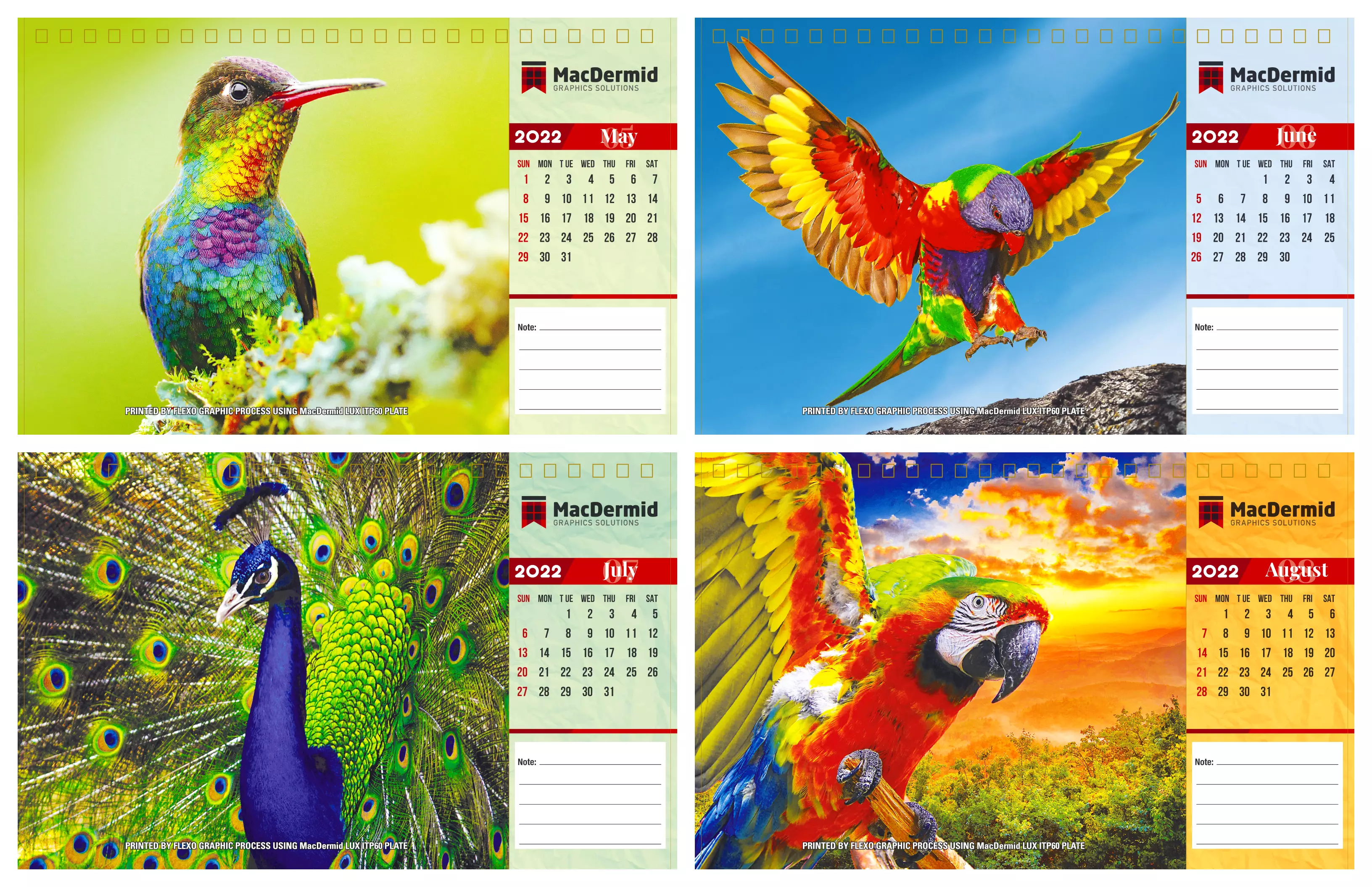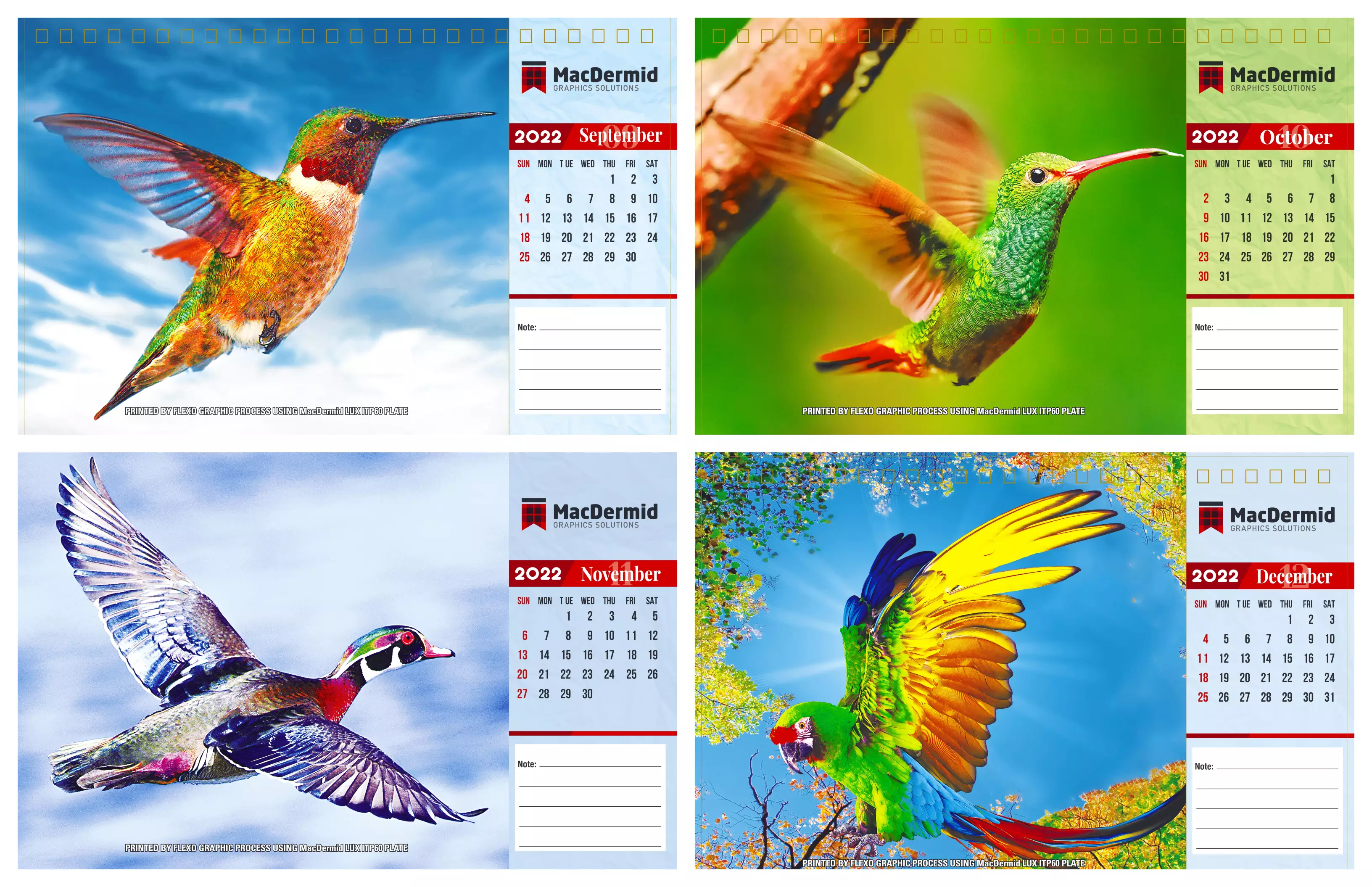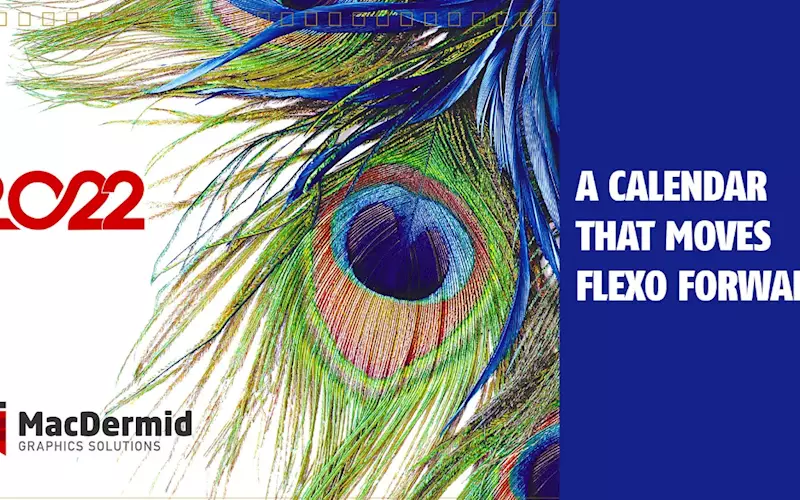A calendar that moves flexo forward - The Noel D'Cunha Sunday Column
A calendar that could quite easily be themed as Flexo Simplified is divided into sections that highlight the prowess of the technology. This includes: the substrates, the design, the artwork and repro, the printing and ink management, the sustainability quotient. And because it is a MacDermid Graphics Solutions calendar, it is also about the importance of flexo platemaking.
A Sunday Column report
09 Jan 2022 | By Noel D'Cunha
Embracing technology is not just an opportunity, but it has become essential in this day and age. Which is why the MacDermid Graphics Solutions calendar was created. The highlights: The screen ruling is 150 LPI and it’s rendered in CMYK OGV along with cold foil matt and gloss varnish as embellishment.
MacDermid Graphics Solutions, a global producer flexographic platemaking and printing solutions has printed 1000 copies of its 2022 calendar. The inspiration? To demonstrate flexo's capabilities as well as MacDermid LUX ITP 60 plate performance.
Prasenjit Das, the company’s cluster senior sales manager for South Asia shared with PrintWeek that "calendars are predominantly printed in offset because of high-quality graphics requirements. Through this initiative, we have successfully demonstrated that with LUX In-the-Plate (ITP) 60 plates and high-quality pre-press and printing, we can achieve better results with flexo."
Das is keenly aware of the new trends in the flexo industry. He speaks of high-quality graphics and run lengths getting shorter. Also, there is a greater emphasis on sustainability and a focus on environmental-friendly inks (water-based). In addition, there is a growing trend for printing with an extended colour gamut – CYMK OGV. He says, "Which is why printers are trying to limit their spot colour inventory." He feels the advances in flexo have been very exciting. These are the elements that have been poured into the calendar.

In a price-sensitive market such as India where every sq cm of a plate is a bargain. We asked him how he manages to provide cost-efficiency and value addition. He said, "The biggest challenge for any trade shop is quick turnaround time, reduction in wastage and reducing or controlling the cost of production. With the recent increase in solvent price, the situation has become very challenging for trade shops to maintain profitability." On cue, he talks about "the industry’s most innovative platemaking equipment – Lava thermal plate processing."
The kit integrates easily with the most popular front-end pre-press systems and software, making it a plug-and-play solution for almost any workflow. The highlights are: press-ready plates in less than an hour; eliminates solvents and VOCs in platemaking; advanced design and improved ergonomics; internal filter system for reduced footprint; automated lid lift for work efficiency; and LED illumination. One of the biggest advantage of MacDermid digital plates is that most of its plates types can be processed both by solvent and thermal system. This brings an unique advantage especially to trade shops in reducing wastage, take advantage of quick turnaround time, minimize solvent usage and control inventory.
The Flexo Xperience Centre
Technology has evolved over the past 25 years, Das says. He says, "In the past, you could produce ten jobs a day. Today you can execute 50 to 100 jobs in a day." What about operator skills? Simple things like: process control; web inspection systems; plate making best practice; process colour and proofing techniques. Das says, "I fully agree that there is a shortage of skilled workers in India, especially in the flexo industry. Various technical institutions and initiatives taken by various industry partners by setting up demo centres, are going to play a very important role in bridging the knowledge gap."
At a global level, MacDermid Graphics Solutions has announced plans for a collaborative endeavour called The Flexo Xperience Centre (The FXC). The centre is a partnership between MacDermid and Soma and is an expansion of their initial plans to install a Soma Optima2 printing press at MacDermid’s facility in Atlanta, GA, USA, announced in December 2020. Das says, "The FXC will include multiple industry-leading partners providing software, equipment, and consumables."
The FXC was conceptualised in 2020 by the leadership, marketing, R&D, and sales teams at MacDermid and Soma while discussing plans to install the printing press and plate mounting equipment at MacDermid's facility. The teams identified a need in the package printing industry for a wide-web flexo printing centre with every aspect of the flexo process, including artwork, pre-press, platemaking, print, print finishing, and print evaluation.

The mission of The Flexo Xperience Centre is "to move flexo forward". This global centre will combine both hands-on and virtual visits for a "one-stop-shop" for the package printing industry's entire workflow to experience the latest flexographic printing innovations. In addition, the FXC will foster and host industry training, collaboration, research, experimentation, and learning, all designed to ensure package printing excellence. The centre will be open to pre-media suppliers, trade shops, printers, converters, consumer product goods companies, industry associations, educational institutions, manufacturers, and other players in the package printing market.
Das says, "We are very confident that Indian label printers, converters and trade shops will visit The FXC and take advantage of this world class facilities ."
Flexo versus others
PrintWeek was talking to a converter in Daman-Silvassa. The feedback: As compared to the earlier times, procuring a gravure cylinder is not as tedious, with a fortnight waiting period. Plus, the cylinder cost has decreased. In such a scenario, why should a converter invest in flexo?
Das says, "Both the technologies have their own advantages. It all depends on what type of jobs you are trying to print? What is the substrate? Plus how much is the quantity."
Also, a lot has changed since 1995. In that year, flexographic computer-to-plate (CTF) was introduced. German Basel Scheel company (now part of Esko) was financed by DuPont to develop a filmless computer platesetter for Cyrel flexographic plates, called CDI (Cyrel Digital Imaging). It uses laser ablation of an integrated black carbon mask on the plate and works with any suitable platemaker. CTF with digital photopolymer plates was a big factor in the quality revolution in flexography (also helped by improvements in presses and anilox inking rollers).
And yet there is a common perception that flexo cannot match gravure’s quality, it can only come close. We asked Das, "how do you convince them to accept flexo?"

He says, By now most of the brand owners are aware of flexo quality and hence we are seeing more and more conversion happening from traditional printing to flexo. We are also witnessing big FMCG companies moving quite a few flagship brands to flexo. These were traditionally being printed in gravure.
When we posed the question about the challenges in offset to flexo conversion jobs in India; he said, the printing of the calendar with flexo provides an answer to this question.
The MacDermid calendar has been printed at Itek in Bengaluru and the pre-press has been rendered by VeePee Graphics.
LUX ITP technology: At a glance
One of the biggest advantages of MacDermid digital plates is that they can be processed as both solvent and thermal. This provides a unique advantage to the trade shop in reducing wastage, taking advantage of quick turnaround time and controlling inventory.
For example, MacDermid's LUX ITP technology enables flat-top dots while using standard platemaking techniques. It works on the principle of chemistry-free thermal processing using heat and an absorbent blanket to remove uncured polymer which is a much faster alternative to solvent washout. This process was originally introduced by DuPont in 2002 with its Fast system. The USP is: No drying is required, although a final UV blast is still needed to de-tack the polymer.
As the A-list brands seek top quality and speed to market, the challenge that the market faces is reduced run lengths and reduced lead times coupled with the increasing complexity of the print jobs. A flexo house has to cope with these challenges. For this, it requires a skilled team that understands the technology plus understands how to maximise it. This is where understanding the nitty-gritty of in-house repro and platemaking helps.
The husband and wife team of P Jaichandra and Nalini at Veepee Graphic Solutions













 See All
See All